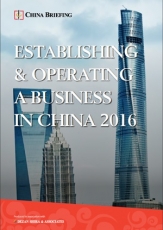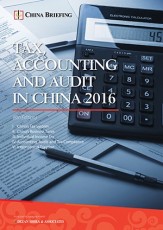Preventing Insolvency: How to Plan the Cash Flow and Financing of a WFOE in China
By Thibaut Minot,
Associate, International Business Advisory, Dezan Shira & Associates
Forecasting the financial performance of a proposed business and accurately assessing the investment required to launch operations is always a complex affair. In China, where foreign currency restrictions significantly complicate cross-border transactions, the strategic planning of funding foreign-invested entities (FIEs) is of particular importance.
This is well illustrated in the case study explored in this article, a scenario that Dezan Shira & Associates commonly encounters while advising clients that have an entity in China or are in the process of setting one up. The case study will not only aim to illustrate the common pitfalls associated with funding a Chinese business, but will also be used to introduce five different strategies available to investors contemplating the funding of a wholly foreign owned enterprise (WFOE).
Scenario
Just six months after incorporation, a foreign-invested company involved in commodities trading runs out of registered capital. The business was established on the premise that revenue would be generated quickly, as a major client had vouched to place a large order and settle the invoice within 90 days. However, the payment on the order was delayed and the trading company could not meet its forecasted cash flow target. Meanwhile, the company incurred significant expenses, having to pay its suppliers for raw materials, its landlord for the large warehouse rented, and its newly-hired employees. Upon being notified of the situation of the FIE in China, the parent company immediately re-initiated registered capital injection installments. However, it took several weeks for the process to be completed and for the capital to arrive in the company’s bank account. As a result of this delay, the company was not able to pay its Chinese employees at the end of the month and make social insurance contributions on time.
This situation is not uncommon in China, and many investors decide to only inject a limited amount of registered capital into their Chinese company at the start, optimistically forecasting rapid income generation and/or underestimating upcoming expenses. In addition, there is the inherent risk of dedicating resources to a new and foreign market, and it is perfectly sensible for investors to seek to keep investments to a minimum until the guarantee of returns becomes apparent. The scenario mentioned above does however raise two critical questions: (i) what options does an investor have to inject capital into a WFOE once injected registered capital runs out?; and (ii) what options are available to efficiently plan the WFOE’s financing in the first place?
Reactive WFOE funding strategies
Option 1 – Injecting registered capital gradually according to cash flow needs
A cautious investor could decide to commit significant registered capital to its FIE in China, while gradually injecting the funds in increments according to the company’s cash flow needs. Capital is not injected fully in one initial transaction so as to avoid the risk of prematurely trapping considerable funds into the Chinese company. Problematically, each injection of capital triggers approval and verification procedures with the State Administration of Foreign Exchanges (SAFE), the body in charge of monitoring foreign currency transactions in China. The whole process generally takes between one to two weeks from the point of remittance to the time at which capital becomes readily available to settle expenses. On top of the costs and inconvenience associated with undertaking these procedures, such a strategy requires the careful anticipation of upcoming obligations well ahead of time so as not to miss payment deadlines. It becomes vital to carefully plan the capital injections so that the WFOE’s funds do not run out in between two capital injection milestones.
![]() RELATED: Pre-Investment and Entry Strategy Advisory from Dezan Shira & Associates
RELATED: Pre-Investment and Entry Strategy Advisory from Dezan Shira & Associates
Option 2 – Increasing the registered capital ceiling committed
If a WFOE runs out of registered capital while having reached the maximum amount that is allowed to be injected, there is always the option of increasing the ceiling of registered capital committed at the start. However, this is not a simple process. Prior authorization from the Administration of Industry and Commerce (AIC) would need to be obtained, and amendments would subsequently need to be made to the entity’s business license and other official records. In effect, many of the steps completed during the incorporation stage of the company would need to be repeated. The whole process can take between eight to twelve weeks, and the time laps involved could jeopardize any business that is running out of funds.
Option 3 – Implementing inter-company service agreements
The investor may also inject funds into its China WFOE in the form of a service fee, with the WFOE entering into service agreements with the parent company overseas. For example, it is common practice for the China entity to provide ‘consulting services’ to the headquarters, with the resulting transaction acting as a funding mechanism. The service fee would be subject to a six percent value-added tax (VAT) rate and related surcharges, although a VAT rebate may apply as the service recipient is located overseas. Additionally, the resulting WFOE revenue remaining as profit is subject to a Corporate Income Tax (CIT) of 25 percent in most instances. Unlike the injection of registered capital, service fees do not constitute a ‘capital account’ transaction, and as such can be organized more rapidly without obtaining prior approval from SAFE directly. Nevertheless, the WFOE’s bank, acting on behalf of SAFE as an enforcement body, will check the supporting documentation and verify the consistency of the transaction with the communicated business purpose. The funds transit via an escrow account and may end up being held up by the bank in the event that its expectations or requirements are not fully satisfied.
It should be noted that in the event of a tax audit further down the timeline, the audited entity may be asked to provide supporting documents proving that the service fees received were based on genuine transactions, such as the service contract. It is therefore important to plan ahead and prepare sound service agreements that limit the risk of raising future undesired scrutiny. Also important to note is that inter-company service agreements may trigger transfer pricing (TP) ramifications if they lead to significant shifting of profits between the two parties. According to the “Public Notice Regarding Refining the Reporting of Related Party Transactions and Administration of Transfer Pricing Documentation” (SAT Public Notice [2016] No. 42), released by the State Administration of Taxation (SAT) on June 29, 2016, the transaction thresholds triggering the need for the preparation of TP documentation are as follows: RMB 200 million for tangible assets transfers; RMB 100 million for financial assets transfers; RMB 100 million for intangible assets transfers; and RMB 40 million for other related party transactions in total. It is critical for taxpayers to be familiar with SAT Public Notice No. 42, and assess their related party transactions according to the new thresholds.
Although these three reactive funding options are certainly appealing for a WFOE that has run out of registered capital, the scenario introduced above further raises a critical question: is there a safer way to commit sufficient capital at the start to avoid the need to later on organize cumbersome capital account transactions or taxable service transactions?
Preemptive WFOE funding strategies
Option 4 – Injecting substantial registered capital from the start
![]() RELATED: Business Advisory Services from Dezan Shira & Associates
RELATED: Business Advisory Services from Dezan Shira & Associates
Injecting considerable registered capital from the beginning insures that the company’s expenses are covered in the long term, without having to go through multiple capital injection rounds. Meanwhile, the amount of registered capital committed to a company is publically available information, and a large registered capital commitment can increase the credibility of the investor in the eyes of potential business partners. However, a rational investor may feel reluctant to over-commit, as excess capital would sit idle in a bank account that brings no returns. The funds could likely be put to a more lucrative use if invested through alternative means, earning a return as a bank deposit or otherwise employed, and thus there is an opportunity cost of over-injecting registered capital into a China company. Additionally, there is always the risk that the value of the money held in the capital account is subject to exchange rate fluctuations, with very limited options available to the investor to quickly respond to such a risk. Furthermore, when the time comes that the WFOE is cash-flow positive and the investor wants to repatriate profits, in most cases registered capital will have to have been fully injected into the WFOE before dividends can be issued. As such, a large registered capital commitment could delay the much anticipated process of profit repatriation.
Option 5 – Committing to registered capital alongside a foreign loan
Within the gap between the total investment into a WFOE and the amount of registered capital committed, authorities allow for a capped loan amount to be arranged between an overseas creditor and the WFOE. Together with registered capital, company loans constitute the total investment injected into the WFOE. Different from the injection of registered capital, a foreign loan can be returned to the shareholder (or related party) in accordance with the terms indicated in the loan agreement. There is considerable flexibility in this regard, as the loan agreement can be amended pending the approval of the relevant authorities. As such, resorting to company loans can help the investor inject money into its WFOE at a relatively low level of risk. Moreover, the application procedures are comparatively simpler than that of the increase of registered capital. It is estimated to require four weeks to register the foreign loan agreement with SAFE and open a specific foreign loan account with the bank. This is two to three times less than the time it takes to increase the registered capital ceiling.
The case study presented demonstrates the complications intrinsic to funding the operations of FIEs in China, and how important it is to carefully assess the different funding options introduced above. Because of the difficulty of correctly anticipating a WFOE’s cash flow needs and the optimal amount of registered capital to inject at the start, it is likely that an investor will have to inject funds during the life of the company, sometimes abruptly in response to a financial constraint. However, each strategy comes with a number of advantages and drawbacks, and as such it is essential to understand the various funding processes and anticipate their consequences. Discussing WFOE funding strategies with a competent advisor is of the utmost importance in order to map out a financing plan that best serves business objectives and mitigates risks.
|
Asia Briefing Ltd. is a subsidiary of Dezan Shira & Associates. Dezan Shira is a specialist foreign direct investment practice, providing corporate establishment, business advisory, tax advisory and compliance, accounting, payroll, due diligence and financial review services to multinationals investing in China, Hong Kong, India, Vietnam, Singapore and the rest of ASEAN. For further information, please email china@dezshira.com or visit www.dezshira.com. Stay up to date with the latest business and investment trends in Asia by subscribing to our complimentary update service featuring news, commentary and regulatory insight.
|

 Establishing & Operating a Business in China 2016
Establishing & Operating a Business in China 2016
Establishing & Operating a Business in China 2016, produced in collaboration with the experts at Dezan Shira & Associates, explores the establishment procedures and related considerations of the Representative Office (RO), and two types of Limited Liability Companies: the Wholly Foreign-owned Enterprise (WFOE) and the Sino-foreign Joint Venture (JV). The guide also includes issues specific to Hong Kong and Singapore holding companies, and details how foreign investors can close a foreign-invested enterprise smoothly in China.
 Tax, Accounting, and Audit in China 2016
Tax, Accounting, and Audit in China 2016
This edition of Tax, Accounting, and Audit in China, updated for 2016, offers a comprehensive overview of the major taxes that foreign investors are likely to encounter when establishing or operating a business in China, as well as other tax-relevant obligations. This concise, detailed, yet pragmatic guide is ideal for CFOs, compliance officers and heads of accounting who must navigate the complex tax and accounting landscape in China in order to effectively manage and strategically plan their China-based operations.
 An Introduction to Doing Business in China 2016
An Introduction to Doing Business in China 2016
Doing Business in China 2016 is designed to introduce the fundamentals of investing in China. Compiled by the professionals at Dezan Shira & Associates in June 2016, this comprehensive guide is ideal not only for businesses looking to enter the Chinese market, but also for companies who already have a presence here and want to keep up-to-date with the most recent and relevant policy changes
- Previous Article China Market Watch: China Reaches Five Year PPI High, and Digitization of Manufacturing Sector
- Next Article A Complete Guide to 2016 Minimum Wage Levels Across China

























